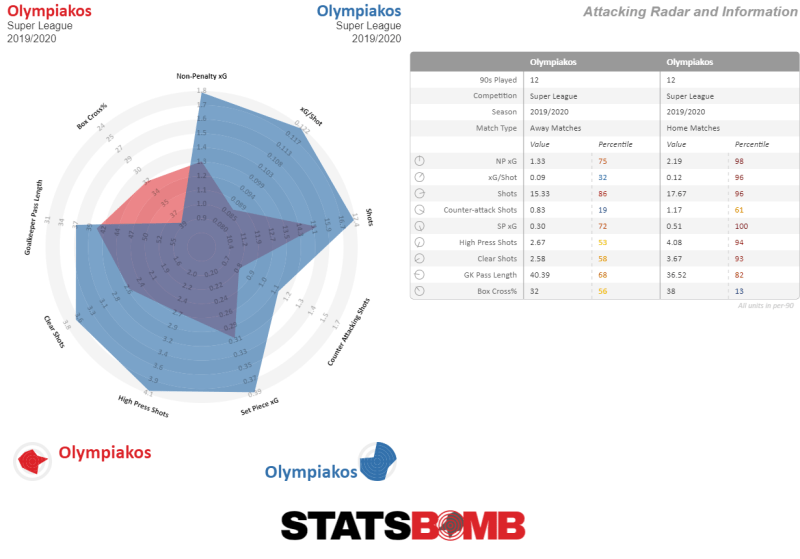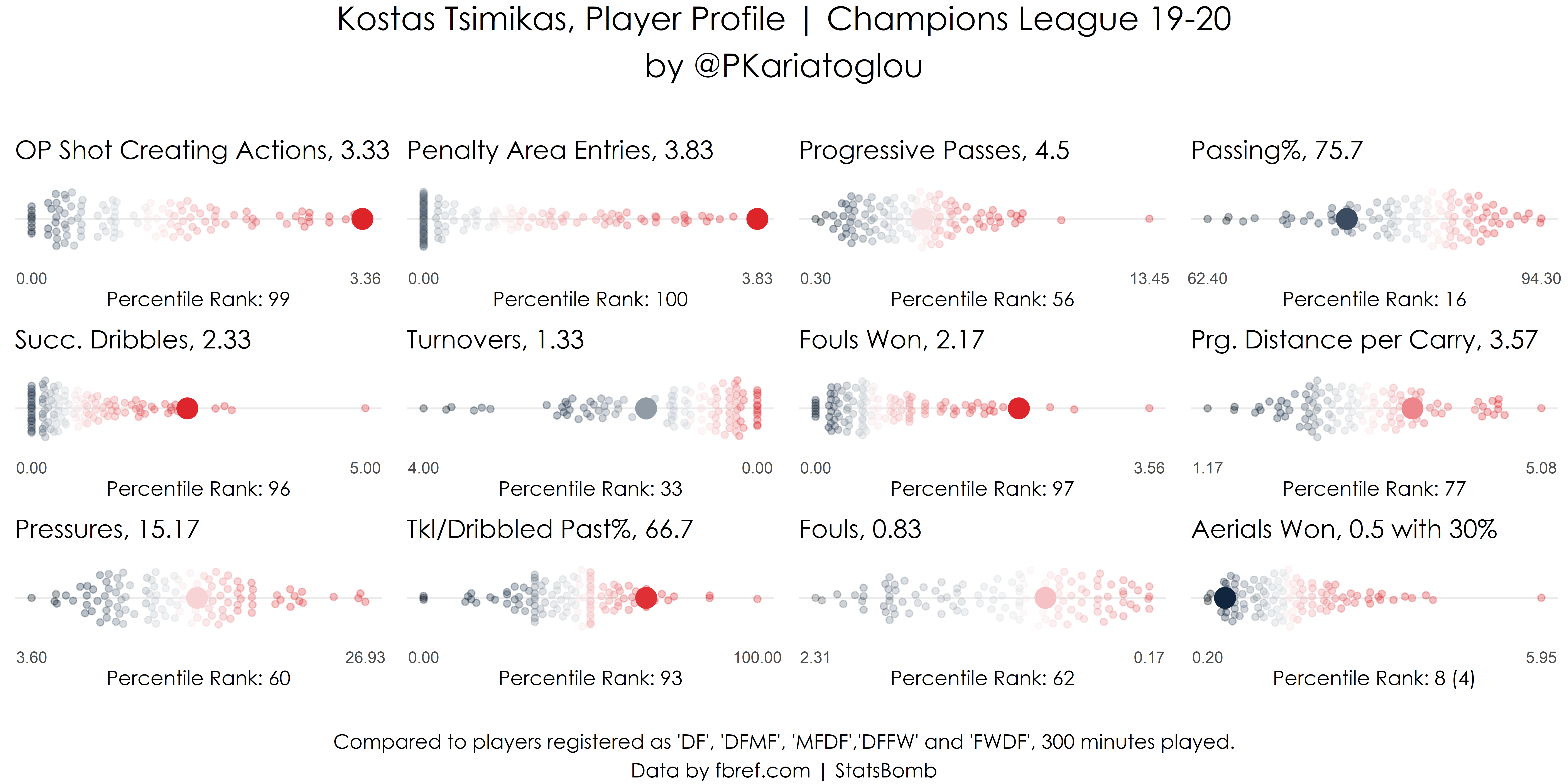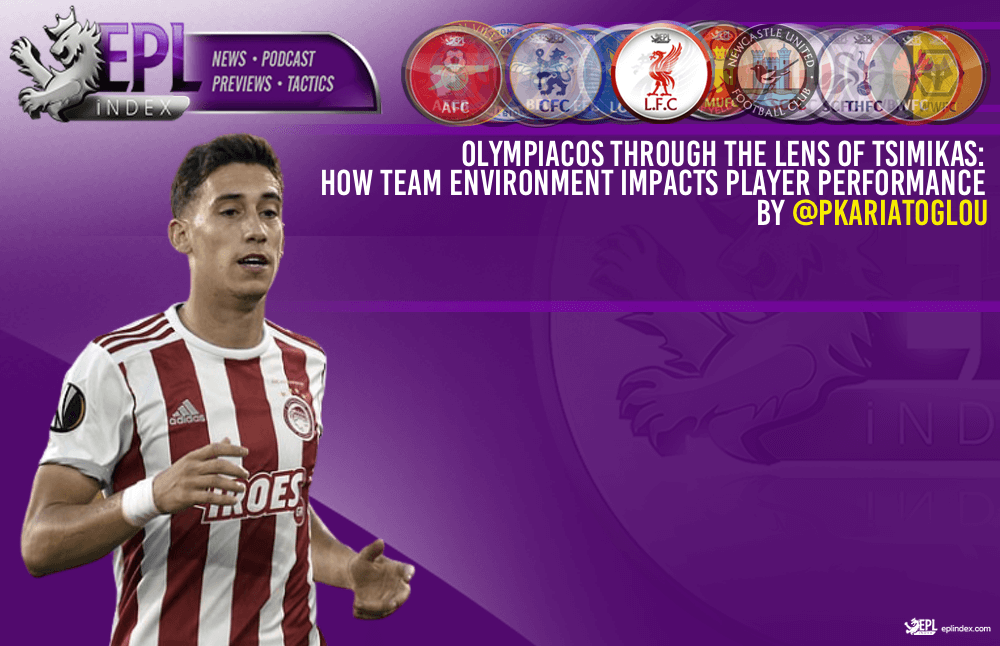The Athletic is suggesting Kostas Tsimikas to cover Robertson at the left-back position for Liverpool next season, describing him as a “type of player who could have a high ceiling given his age, potential price and profile on the pitch” gives me a very good excuse, not to discuss that exact opportunity, but to assess if and how a 24 year old from the Greek League can be that good.
He’s probably not that unknown, though, to the football community, especially the Premier League fans. Since the start of the season Olympiacos has faced English teams five times: they drew one and lost one versus Tottenham in the Champions League Group Stage, eliminated Arsenal from Europa League’s Round of 32 and will play the return match against Wolves (after drawing 1–1 at home) claiming their position in the Final 8 in August 6. Not bad at all.
In this campaign, Tsimikas has been an incredibly valuable asset in Olympiacos’ machine. Irreplaceable even. But how influential could he be for a better, more talented team in one of Europe’s major leagues? Team environment can have a huge impact on a player’s performance. Some players are favoured by the environment they play in while others play for teams whose style of play doesn’t get the best out of their skillset.
In our case, it’s the first one that applies. So before talking more specifically about Tsimikas, I’m asking for your permission to babble a bit about what Olympiacos tries to do on the pitch, basically offensively and how that impacts Tsimikas’ performance.
Team context
Pedro Martins’ side, in his second season in charge, after losing its best player, Kostas Fortounis, with an anterior cruciate ligament rupture, in an off-season friendly for the biggest part of the season, had to reinvent itself and find alternative ways to attack, just a few days before their first game for the Champions League qualifiers. For the previous four seasons Fortounis had been Olympiacos most important player breaking down the (very) deep defences the Reds face in the Greek Super League, averaging 0.8 non-penalty goals and assists per 90, per season, split almost even.
Without him, Olympiacos couldn’t break down the opponents with through balls and penetrate from central areas as much as before. He had been the do-it-all man in Olympiacos offence, scoring, serving and dropping deep to progress the ball forwards. Mathieu Valbuena who joined on a free weeks before Fortounis got injured, was brought to offer some quality minutes between him and Podence (who departed in January for Wolves), but eventually was brought into a situation where he had to play week in week out. And as good as the French veteran might be at creating chances for his teammates, his game doesn’t nearly approach the multi-layered attacking influence of his Greek teammate.
What Valbuena could offer, in terms of end product, was good crossing and mastered set-piece deliveries. And these are two aspects of Olympiacos’ domestic attacking production and style of play that reflect pretty clearly in their attacking radar (2 fixtures before the end of Super League Greece’s regular season), courtesy of StatsBomb. Reds’ attacking output, especially at home, was that of a title-winning team. But the thing is that teams from that kind of leagues, by nature play a different game domestically compared to when they face opponents from the Big-5 leagues in Europe.

However, as much as a different approach these teams might adapt, at the end of the day the habits and automatisms remain the same. And when things get tough, it’s your habits that get you going. In this case, stats-wise, Olympiacos’ habits that remained the same across competitions were a whole bunch of crosses and a subsequent inability to create high-quality shots from open play. Just take a look at the radar above and the huge drop in most metrics between home and away matches. Without the home-field advantage Olympiacos struggled more to create from all kinds of situations.
Their Box Cross% (the percentage of penalty area entries that come through crossing) reached the amount of 38% when playing at home and 32% away. How did that transition to the Champions League? 37% with a 22% success rate in crossing, both highest in the league. Domestic competition, with a huge gap separating Olympiacos from their competitors, didn’t reveal at a high rate the flaws of such a cross-heavy approach, but in Europe they had a hard time finding quality chances.
Pedro Martins prioritized volume over quality, with an npxG per shot of just 0.08. Early crosses and direct attacks lead the way for Olympiacos. Every time they managed to move the ball to the final third, they tried their luck without a second thought, having the lowest number of final third passes per shot in the Champions League. With efficient ball carriers in the squad (especially Podence) the Reds could create dangerous situations on the counter, but many ended up with hasty decisions, seemingly as part of the shot-whenever-you-can strategy.
So if they cross a lot and have a hard time finding quality shots, how did they score and pass stages? In Champions League, 4 points were enough to finish 3rd over Red Star and in Europa League knockouts, not being much worse than your opponent sometimes does the job, with Olympiacos qualifying over Arsenal on the aggregate.
But to answer the question of how they scored, the answer lies between football’s hidden treasure, set pieces, a few long-range shots and penalties. Olympiacos scored four of their thirteen goals in the qualifying rounds of the Champions League (31% and 0.67 per 90) from set-piece situations, and four of their eleven goals in the group stage and the Europa League knockouts (36% and 0.43 per 90).
Player Analysis
OK, now that I gave you the general context around how Olympiacos tried to score against superior sides in Europe, it’s time to talk about the Greek guy (who I purposefully didn’t mention in the first part) and has drawn the attention of several elite European sides.

*Quick Note*
What you see above is a player profile chart (for fullback’s) I designed using data from FBref and StatsBomb.
In the first row I chose metrics that show us how much a player contributes to his team’s attack, in the second row I tried to select metrics that show us how progressive and how much risk-reward his ball carrying is and in the third row some defensive, mainly, stats.
You probably noticed that the more traditional defensive stats, like tackles and interceptions, are missing. I decided not to include them as without being possession adjusted these numbers can be misleading.
Also beware: small sample size alert!
*End Note*
As Olympiacos play became more cross-oriented after Fortounis’ injury, it was tailor-made for Tsimikas’ talents. And these are those of a good, traditional overlapping full-back. He’s a high volume shot creator (more than any defender in the Champions League this year), whose abilities lie on-ball, especially as a ball-carrier. Tsimikas can dribble and carry the ball forwards with incredible pace and create with crosses from deep, without being a liability defensively with noticeable 1v1 defending numbers. His passing success rate is reasonably low, given the numerous crosses he attempts and his progressive passing, well, it’s not his thing, without being exceedingly bad at it. He has a preference for carrying the ball into the opposition third than passing it.
Him being an Olympiacos academy product, the Reds knew exactly what he needed to excel; space to dribble and cross. Most of Olympiacos’ sequences are built to create space for Tsimikas on the left. In their most-used in Europe 4–3–3-type formation, the Greek side tried to build-up from the right side, but mostly to then make a quick switch to the left, once the opportunity arose. By overloading the right flank, recycling possession and narrowing the play-field, the Reds could isolate Tsimikas, usually with the opposition winger, on the other side, and play a nice switch to him at the correct moment.
Those kinds of switches have been crucial for Olympiacos offensive production, taking the best out of Tsimikas’ skillset, whilst eschewing the lack of progressive, vertical passing from their midfielders, who on the flip side are great at playing 40yds+ sideways switches of play. A stat I really like and which highlights that behaviour comes from whoscored. According to their positional statistics, 43% of Olympiacos attacks came from their right side, but the same rate of their penalty area entries were from the left and Tsimikas’ legs!
There are also times when Olympiacos tries to achieve a classic winger-fullback combination with Masouras coming short to play one-two’s with Tsimikas, but those sequences usually don’t end up successfully for various, mostly systemic, reasons. One of those reasons is Olympiacos wider aforementioned problem of preferring a long-range (and often wide) shot over a more patient sequence that can result in a better chance. Another reason, and one where Tsimikas is, partly, to blame, is his vision when receiving in the “cutback zone”. In these situations he rarely makes the most optimum choice, opting for a far-post cross over an easier pass. And I said partly because his teammates runs in those situations are also far from optimal. If you exclude Masouras and El-Arabi, none of the other players in Olympiacos’ European squad is equipped with an ability to make dangerous runs into the box.
In the compilation above, 3 of the clips I selected are from their last match in the Champions League group stage against Red Star and the last one is from the first-leg fixture against Wolves. Against Red Star you see Tsimikas at his best; an unstoppable force from the left, receiving with space in the wing, winning fouls and getting past opponents to pump balls into the box for his teammates. Briefly, doing everything his side asks him to do. In the last clip from the Wolves’ game, you see what happens when the opposition reads Olympiacos intentions and adjusts quickly.
Europa League found Tsimikas’ numbers dropping dramatically compared to Champions League. Again, the sample is even smaller, and different/weirder when accounting that these were knockout matches, with extra time minutes and Olympiacos defending a lead at Emirates and another 60 minutes of them playing with 10 men against Wolves. But further than the circumstances that lead to a more defensive than usual approach from Olympiacos, Arsenal and Wolves were great at limiting Tsimikas’ attacking influence in their encounter with the Greeks.
And I think that’s due to the same reason that made the difference for him in the Champions League; space. Curiously, Olympiacos spent more time on the ball against the English sides, but in non-dangerous areas and with an organized defence in front of them. Without the penetration Podence could offer with his dribbling from the right, Olympiacos could only expect a Tsimikas’ run to be dangerous in open-play and the English sides knew that.
Tsimikas was forced to receive deeper and with the passing lanes blocked his final third passes dropped from 2.6 per 90 to 0.7. Instead, he made more low-risk choices in his passing, opting for a safe side or backwards pass to the centre backs. As for his carrying, without Masouras on the left who could create space for him with his runs, he was again forced to make less progressive choices.
Champions League numbers paint the picture of what Tsimikas can be at his best, supported with the right pieces. A team willing to play from the sides, with mid runners and a winger tasked to cut inside to give him space and support him defensively, would be the ideal environment for him. On the other side, Europa League battles showed the limitations of his passing range and underlined the power of team environment over player performance.
Where could he end up
Evaluating players from smaller leagues is hard. And it certainly requires more data and more video work than I did. From my experience watching Tsimikas I think that he would be a decent option for most teams in the Big-5 leagues and with reports coming out, I can see why a team like Leicester or Napoli might be interested.
Theoretically, he’d also be a good fit for Liverpool. He has similarities with Robertson (although I have some thoughts on his off-ball movement and ability to receive in the box compared to that of Robertson’s) and in case Liverpool want someone to rotate systematically with Robertson in the crowded fixtures of the 2020–21 season, then he might be their man. If that’s not the case, with his price tag from Olympiacos set around 15 million euros, I don’t think he’s a viable option for them, given that he’s not an upcoming youngster who’ll be a future Robertson replacement when he starts to decline, but a player who’s entered his prime years.
Tsimikas at 24, is at the side of the age curve you’d want your starting fullback to be. In these terms, with Napoli’s left-backs at the wrong side of that curve, I think that he would be one of the best options for them.

